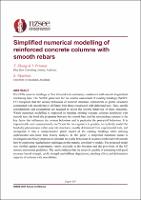Simplified numerical modeling of reinforced concrete columns with smooth rebars
Abstract
Pre-1970s concrete buildings in New Zealand were commonly constructed with smooth longitudinal reinforcing bars. The NZSEE guideline for the seismic assessment of existing buildings (NZSEE C5) recognizes that the seismic behavior of structural concrete components or global structures constructed with smooth bars are different to those constructed with deformed bars. Thus, careful considerations and assumptions are required to assess the seismic behavior of these structures. Where numerical modeling employed to simulate existing concrete columns reinforced with smooth bars, bond-slip properties between the smooth bars and the surrounding concrete is the key factor that influences the column behavior and in particular the post-yield behavior. It is impracticable and computationally inefficient for the engineers in practice, to explicitly model the bond-slip phenomenon within the concrete structures, usually determined from experimental tests, and incorporate it into a comprehensive global model of the existing buildings while utilizing the sophisticated non-linear time history analysis. In this paper, a simplified numerical model is investigated and finally proposed to simulate the cyclic behavior of columns reinforced with smooth bars by employing regularization techniques to the material constitutive models. The proposed model was verified against experimental results available in the literature and the provisions of NZ seismic assessment guidelines. The results indicate that the model was capable of estimating the initial stiffness, flexural strength and strength degradation of columns with smooth bars with good accuracy.

